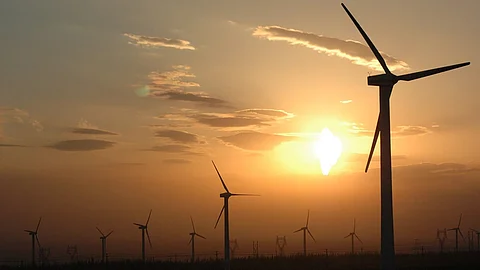

New Delhi: India’s wind energy capacity is projected to reach 107 GW by 2030, exceeding the government’s 100 GW target, according to the Global Wind Energy Council (GWEC). The findings were released on Tuesday in the report Wind at the Core: Driving India's Green Ambitions and International Influence, unveiled in the presence of New & Renewable Energy Secretary Santosh Kumar Sarangi.
Follow Energy Watch on X
The report said installed wind capacity can more than double from 51 GW at present to 107 GW by 2030, in line with state-level Resource Adequacy Plans (RAP). This, it noted, is pivotal for achieving the least-cost pathway for India’s energy transition.
International organisations such as NREL, IEA, WRI, and Lawrence Berkeley recommend even higher wind capacity of 121–164 GW by 2030. The report added that addressing grid concerns, strengthening Renewable Purchase Obligation (RPO) compliance, and aligning bidding processes with state offtake needs could push installations toward the full potential.
India’s total wind potential stands at 1,164 GW, of which only 4.5 percent has been utilised so far. Scaling installations to 8 GW annually could create 1,16,000 jobs, reduce costs by 10 percent and raise domestic content to 80 percent. Annual additions of 15 GW could generate 1,54,000 jobs.
On the occasion, Sarangi said, “About 30 GW of wind energy projects are in different stages of implementation, which would be operational over the next couple of years,” adding that he hoped India would add six to seven GW of wind energy capacity this year.
On the impact of US tariffs on renewable energy equipment manufacturers in India, he noted: “Solar and wind exports to the US from India are not very high. I don't think there will be a significant impact on industries (RE in India).”
Union Minister of New & Renewable Energy Pralhad Joshi underlined the government’s commitment: “We are committed to installing 500 GW of non-fossil capacity by 2030, including 100 GW wind. With wind expected to contribute nearly a quarter of the renewable mix, India is not only building clean energy infrastructure, but we are also building the future.”
India is now the third-largest wind manufacturing hub, set to meet 10 per cent of global demand, the report noted. The country recorded 3 GW of wind energy equipment exports last year against a global export market size of 117 GW, expected to rise to 135 GW this year. About 60 percent of this market is currently dominated by China.
“By 2030, renewables are expected to supply nearly half of global electricity, with wind contributing 20–25 percent. India is poised to mirror this trajectory, doubling its wind capacity to 100 GW and scaling up to 452 GW by 2050,” said Girish Tanti, Chairman, GWEC India & Indian Wind Turbine Manufacturers Association (IWTMA).
Ben Backwell, CEO of the Global Wind Energy Council, added: “Scaling India's wind capacity to over 100 GW by 2030 can unlock economic growth, manufacturing expansion, and wider energy access.”
Follow Energy Watch on LinkedIN
According to the GWEC report, India’s wind manufacturing capacity has expanded from 12 GW in 2022 to 20 GW in 2024, positioning the country to meet 10 percent of global demand. With accelerated adoption, India’s wind capacity could reach 452 GW by 2050.
